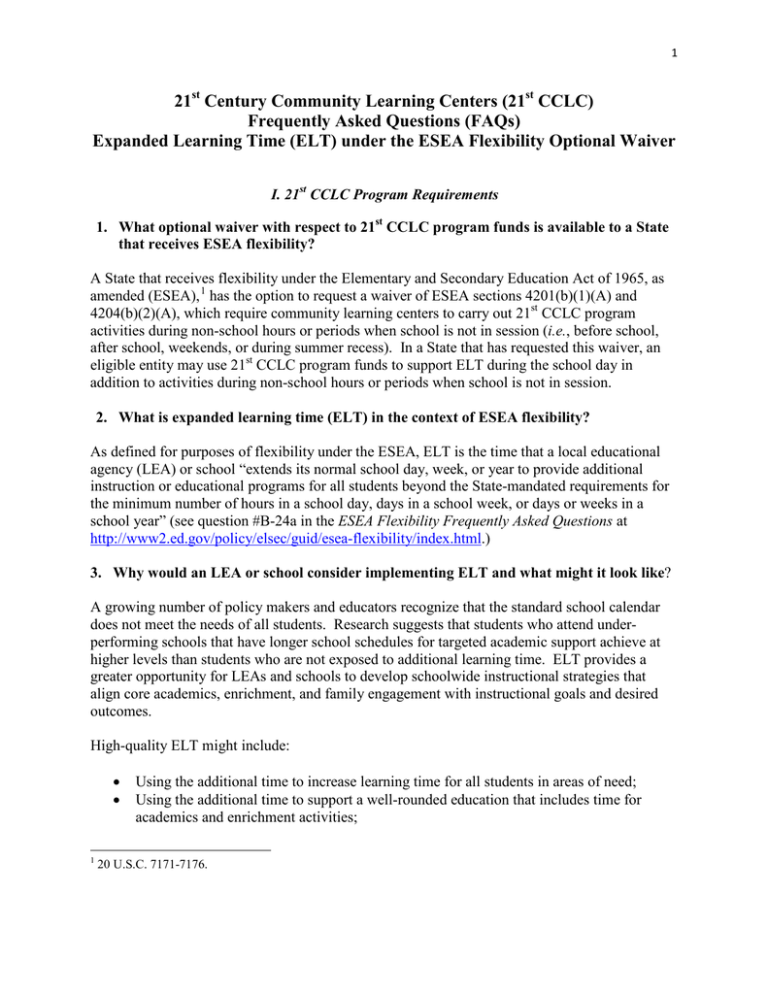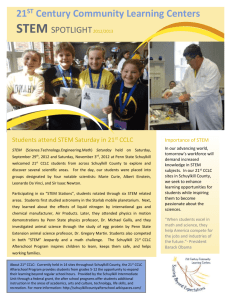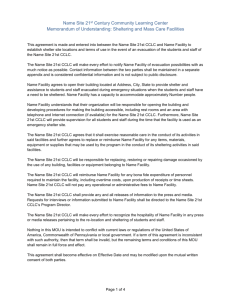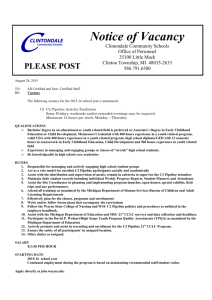21 Century Community Learning Centers (21 CCLC) Frequently Asked Questions (FAQs)
advertisement

1 21st Century Community Learning Centers (21st CCLC) Frequently Asked Questions (FAQs) Expanded Learning Time (ELT) under the ESEA Flexibility Optional Waiver I. 21st CCLC Program Requirements 1. What optional waiver with respect to 21st CCLC program funds is available to a State that receives ESEA flexibility? A State that receives flexibility under the Elementary and Secondary Education Act of 1965, as amended (ESEA), 1 has the option to request a waiver of ESEA sections 4201(b)(1)(A) and 4204(b)(2)(A), which require community learning centers to carry out 21st CCLC program activities during non-school hours or periods when school is not in session (i.e., before school, after school, weekends, or during summer recess). In a State that has requested this waiver, an eligible entity may use 21st CCLC program funds to support ELT during the school day in addition to activities during non-school hours or periods when school is not in session. 2. What is expanded learning time (ELT) in the context of ESEA flexibility? As defined for purposes of flexibility under the ESEA, ELT is the time that a local educational agency (LEA) or school “extends its normal school day, week, or year to provide additional instruction or educational programs for all students beyond the State-mandated requirements for the minimum number of hours in a school day, days in a school week, or days or weeks in a school year” (see question #B-24a in the ESEA Flexibility Frequently Asked Questions at http://www2.ed.gov/policy/elsec/guid/esea-flexibility/index.html.) 3. Why would an LEA or school consider implementing ELT and what might it look like? A growing number of policy makers and educators recognize that the standard school calendar does not meet the needs of all students. Research suggests that students who attend underperforming schools that have longer school schedules for targeted academic support achieve at higher levels than students who are not exposed to additional learning time. ELT provides a greater opportunity for LEAs and schools to develop schoolwide instructional strategies that align core academics, enrichment, and family engagement with instructional goals and desired outcomes. High-quality ELT might include: • • 1 Using the additional time to increase learning time for all students in areas of need; Using the additional time to support a well-rounded education that includes time for academics and enrichment activities; 20 U.S.C. 7171-7176. 2 • • • • • • • Providing additional time for teacher collaboration and common planning; Partnering with one or more outside organizations, such as a nonprofit organization with demonstrated experience in improving student achievement; Redesigning the whole school day to use time more strategically, especially in designing activities that are not “more of the same”; Providing evidence-based activities and programs; Personalizing instructional student supports; Using data to inform ELT activities and practices; and Directly aligning ELT activities to student achievement and preparation for college and careers. 4. How can 21st CCLC program funds support ELT? One of the goals of the 21st CCLC program is to provide academic and enrichment activities for students who would benefit most from ELT. Eligible entities in States that have approved requests for ESEA flexibility and an optional waiver of Sections 4201(b)(1)(A) and 4204(b)(2)(A) of the ESEA may apply to their State educational agency (SEA) to use 21st CCLC program funds during the school day to support ELT. 5. When using 21st CCLC program funds to support ELT, which 21st CCLC program requirements do SEAs, LEAs, community-based organizations (CBOs), and other eligible entities have to meet? SEAs and subgrantees, including LEAs, CBOs, and other eligible entities, must meet all 21st CCLC requirements when using program funds to support ELT. The optional 21st CCLC waiver, as requested by SEAs under ESEA flexibility, only affects when services provided with 21st CCLC funds may be delivered. Therefore, in a State that has received ESEA flexibility and, as part of its request, a waiver of the requirement to provide activities outside the regular school day, authorized activities under the 21st CCLC program may be implemented during the school day as well as before school, after school, on weekends, and during the summer. Absent ESEA flexibility and the optional waiver, 21st CCLC services must be provided outside the regular school day. All other provisions of the 21st CCLC program remain unchanged, including the allocation of funds to SEAs by formula; the requirement that SEAs use 95 percent of their State formula grants to make competitive subgrants; the requirement that SEAs give priority to partnerships between LEAs receiving Title I, Part A funds and CBOs or other public or private entities; the supplement-not-supplant requirement (see also FAQ #19 below); and the entities eligible to compete for subgrants (i.e., LEAs, CBOs, faith-based organizations (FBOs), other public or private entities, and consortia of those entities). Section 4203 of the ESEA requires that SEAs make awards only to eligible entities that propose to serve (a) primarily students who attend schools eligible for schoolwide programs under section 1114 or schools that serve a high percentage of students from low-income families; and (b) the families of the students to be served by the program. In addition, the requirement to provide equitable services to eligible private school students in Section 9501 of the ESEA may not be waived (see FAQ #13 below). 3 6. If a subgrantee uses 21st CCLC program funds to support ELT, do the activities allowable under the 21st CCLC program change? No. The activities that are allowable under the 21st CCLC program do not change; only the time at which they may be offered changes (see Section 4205(a) of the ESEA). 7. If a subgrantee takes advantage of the optional waiver under ESEA flexibility, must it use 21st CCLC program funds exclusively during ELT? No. As defined, ELT means expanding the school day, week, or year beyond the State-mandated requirements for the minimum number of hours in a school day, days in a school week, or days or weeks in a school year (see FAQ #2).1). In other words, ELT is a quantifiable amount of additional time — hours, days, or weeks. The optional 21st CCLC waiver available under ESEA flexibility authorizes the use of 21st CCLC program funds during the school day to support ELT. It does not require, however, that 21st CCLC activities occur only during ELT. (See also FAQ #15 below.) 8. Must an eligible entity use 21st CCLC program funds to support ELT? No. The ESEA flexibility waiver authorizes an additional, but not exclusive, use of 21st CCLC program funds for activities that support ELT. Before-school and after-school programs, as well as weekend and summer programs, remain allowable uses of 21st CCLC program funds. 9. Are current 21st CCLC subgrantees eligible to implement the flexibility afforded by the 21st CCLC waiver under ESEA flexibility? Under certain conditions, as established by individual States, an existing 21st CCLC subgrantee may implement the flexibility afforded by the 21st CCLC waiver under ESEA flexibility. The use of 21st CCLC funds by an existing subgrantee to support ELT must be approved by the SEA and may not involve a substantial change in the scope or objectives of the existing project. While a change in the time when services are provided is permissible, the activities conducted using 21st CCLC funds, the partners committed to the project, and other conditions (such as funding level and qualifications or skills of key staff) must remain the same as those identified in the existing State-approved application. To use 21st CCLC funds to support ELT, an existing subgrantee must submit a written request to its SEA for approval to amend its 21st CCLC subgrant application. If approval is appropriate, the SEA must approve the subgrantee’s request to amend its application to use 21st CCLC program funds to support ELT prior to implementation of the amendment. 10. Must a school or LEA expand learning time prior to an eligible entity applying for a 21st CCLC subgrant to support ELT? No. A school or LEA is not required to have implemented ELT prior to submitting an application (or prior to an eligible entity submitting an application as part of a partnership agreement) for a subgrant to use 21st CCLC funds to support ELT. However, an SEA must have received the optional waiver under ESEA flexibility prior to awarding, or approving an 4 amendment to, a subgrant to use 21st CCLC program funds to support ELT. When soliciting proposals to use 21st CCLC funds to support ELT, the SEA should conduct its competition in a manner that requires the applicant to present a plan and outline the actions it will take to ensure that the school or LEA has implemented ELT by the time 21st CCLC program funds are made available. Please note that the 21st CCLC statute does not allow program funds to be used to provide a planning period for development of a future program. 11. How can eligible entities that are not LEAs, such as CBOs and FBOs, apply to use 21st CCLC program funds to support ELT? Non-LEA eligible entities may apply to use 21st CCLC funds to carry out authorized activities on the same basis as LEAs. Although CBOs, FBOs, and other non-school entities do not have the authority to expand the school day, week, or year, providing 21st CCLC programs that support ELT offers a new opportunity for CBOs, FBOs, and other public and private educational entities to support schools, students, and families during the school day. Since districts and schools make the decision to expand the school day, year or week, non-LEA eligible entities should work closely with LEAs and schools to explore ways to provide academic and enrichment activities to students and professional development to teachers, principals, and other school officials to support ELT. Some research suggests that, if implemented successfully, such partnerships between school personnel and community organizations become embedded in the school community, which in turn helps to create stability, routine, and structure for students — key ingredients for student success. Under certain circumstances, priority must be given to LEAs receiving Title I, Part A funds that partner with a CBO or other public or private entity (see Section 4204(i)(1)(B) of the ESEA). Additional resources on ELT for non-LEA eligible entities can be found on the Department’s Web site at http://www2.ed.gov/about/inits/list/fbci/expanding.html under Expanded Learning Resources. 12. Are there general strategies for how LEAs, CBOs, FBOs, and other eligible entities can work together to carry out 21st CCLC activities to support ELT during the school day? An LEA might partner with a non-school entity, such as a CBO or FBO, to apply for a 21st CCLC subgrant to support ELT. Alternatively, a non-LEA eligible entity might apply for a 21st CCLC subgrant after partnering with an LEA to provide academic or enrichment activities in schools during an expanded school day. The following list offers examples of strategies that have demonstrated success for developing and strengthening such partnerships: • • • LEAs involve community partners early in the planning process to analyze data and share ideas on ways to achieve student success. All partners are part of a management team responsible for maintaining ongoing communication, identifying and agreeing to clear expectations and roles assigned to each partner, and supporting the policies and procedures of the schools in which ELT is taking place. Subgrantee partners coordinate and, when appropriate, establish agreements with other organizations that are working with the same schools and students. 5 • • • • • • Non-school staffs participate in school-based professional development along with teachers and other school officials. All partners commit to identifying adequate funding and in-kind resources to sustain support for ELT. All partners jointly establish program direction and priorities, including planning, budgeting, training and aligning program staff, communicating across the partnership, and continuously improving program services. All partners coordinate to promote school and community safety, reinforce health and wellness programming, and provide necessary student supports. All partners share information, data, performance measures, and evaluation strategies that guide project management, resource allocation, and service delivery while maintaining data privacy requirements. All partners develop a plan that addresses the interactions with families to strengthen positive family engagement that reinforces learning in multiple settings. 13. How does the equitable services provision for eligible private school students apply to 21st CCLC activities carried out in public schools during an expanded school day? Subgrantees remain obligated to comply with Section 9501 of the ESEA (20 U.S.C. 7881) when implementing 21st CCLC activities that support ELT during the school day. Under section 9501, each 21st CCLC subgrantee must provide equitable services to private school students and their families. A subgrantee generally meets this requirement by offering private school students in the area served by the subgrant comparable opportunities to participate in the 21st CCLC program. If a subgrantee in a State with ESEA flexibility receives funds to provide 21st CCLC activities during the school day, however, it may be difficult to include eligible private school students in those activities. Meeting the equitable services requirement in this instance may require the subgrantee to provide the opportunity for private school students to participate in the 21st CCLC activities implemented to support ELT at the public school, or to offer comparable 21st CCLC activities during the school day in private schools. With respect to any 21st CCLC activities, a subgrantee must consult with private school officials during the design and development of the 21st CCLC program on issues such as how the private school students’ needs will be identified and the services that will be offered through the 21st CCLC program. This consultation must take place before the LEA, CBO or other public or private entity makes any decision that affects the opportunities of eligible private school students, teachers, and other educational personnel to participate in the program. Services and benefits provided to private school students must be secular, neutral, and non-ideological. It should also be noted that a private school is eligible to apply directly to the SEA for a 21st CCLC subgrant on its own behalf, although such funds may not be used to support ELT in a private school. 14. How may an SEA award 21st CCLC subgrants for the required three- to five-year grant period to a subgrantee that applies to use 21st CCLC program funds to support ELT when the ESEA flexibility waiver is approved for only two years? 6 Section 4203(a)(8)(A) of the ESEA requires an SEA to make awards for 21st CCLC programs for a period of not less than three years and not more than five years (20 U.S.C. 7174(g)). Under ESEA flexibility, the Secretary is generally granting waivers to SEAs that requested flexibility in Window 1 or Window 2 through the end of the 2013–2014 school year, with the option to request a renewal through the 2014–2015 school year. The Department expects that agreements effective at the time of a 21st CCLC subgrantee award, including the application criteria to which the successful applicant responded, would remain unchanged and in effect for the entire duration of the grant. Accordingly, an SEA may request an extension of the ESEA flexibility waiver from the Department for an additional year, consistent with the Secretary’s authority under Section 9401(d) of the ESEA. 15. Is there a minimum number of hours that a school day, week, or year must be expanded before a 21st CCLC subgrantee may use 21st CCLC funds to support ELT? Although ED has not established a minimum number of hours by which a school or LEA must expand learning time in order for a 21st CCLC subgrantee to take advantage of the optional ESEA flexibility waiver, the school day, week, or year should be expanded significantly; that is, adding a few days or a few hours a week would not be considered significant. In determining what is significant, the school or LEA should have a reasonable basis for believing that the additional learning time will advance student academic achievement. 16. What are some examples of models or activities that a 21st CCLC subgrantee might consider, consistent with the 21st CCLC optional waiver for ELT? The following are examples of ELT activities that a 21st CCLC subgrantee might support: Model 1: Personalization—An LEA expanded its K-5 elementary school day by one 50-minute period based on assessments of students’ achievement data and needs. The school’s primary objective for this additional time is to provide targeted math interventions and enrichment opportunities to students, with the amount and intensity of services varying depending on individual needs. Teacher teams are assigned to develop an individualized learning plan for each student for use during this expanded time. The plans include a combination of math interventions and enrichment opportunities based on each student’s needs, with school staff employing targeted intervention strategies alongside local partner organizations, including a science museum and public library, that deliver enrichment opportunities. Model 2: Partnerships—A middle school offers a nine-hour day three days per week to allow all students an opportunity to participate in enrichment activities — some of which are supported with 21st CCLC funds — designed to nurture interpersonal, behavioral, and organizational skills as well as to provide exposure to programming offered at the local high schools. Students choose from a wide variety of electives, including engineering, performing arts, and poetry writing. Electives are taught by school staff and professionals from local private and nonprofit organizations, including some that also support instruction in local high school career academy and Career and Technical Education (CTE) courses. CBOs 7 and the schools collaborate closely including joint planning, training, data analysis, and continuous improvement activities designed to support student success. Younger students participate in courses developed and delivered by one of the partners that focus on enhancing communication, writing and leadership skills. Older students participate in project-based learning activities that are co-taught by their teachers and experts from partner organizations. Model 3: College and Career Focus—An LEA expanded the school day and year beyond what was required by the State, so that high school students attend school for nine hours daily for 200 days per year. With staff and resource support from nearby colleges and universities, the expanded learning time curriculum includes a preparation course for the State college placement exam and mini-courses supported by school staff, college students, and college staff who guide students’ college search strategies, essay writing, and career exploration. Activities are specifically designed to help each student explore college and career options, and to help ensure that they are gaining the problem-solving skills and creativity required in today’s global economy. Each local partner works closely with school counselors and teachers to identify and develop activities that address a school- or student-identified need. High school and college counselors also deliver group and individual sessions to ninth graders to teach them how to track their credit accumulation and eligibility for admission to State colleges and universities. 17. How can digital learning support ELT? ELT can provide new opportunities for collaboration through partnerships that are built on digital learning or blended learning. Digital learning provides a critical opportunity to transform how schools, parents, and CBOs collaborate to ignite student curiosity and engagement. Using 21st CCLC program funds, digital learning partnerships can expand internet access, boost digital literacy, increase the scope and effect of volunteer and service partnerships, and open avenues to anytime/anywhere learning. Digital learning can also open up new avenues for students with blindness, dyslexia, or other print disabilities to access educational content. In accordance with Section 504 of the Rehabilitation Act of 1973, grant recipients must ensure that all digital learning opportunities are fully accessible. Some evidence suggests that LEAs and community partners who share data work better together and establish better functioning relationships. ELT provides additional opportunities to use technology to share data among schools, families, and community-based partners. A new report from the Department, Expanding Evidence Approaches for Learning in a Digital World, highlights the need for more efforts that connect community partners with school data systems (http://www.ed.gov/edblogs/technology/evidence-framework/). The report emphasizes that “young people learn and develop in a wide range of settings” and that we need to use data more effectively “to support the full range of student needs and interests—both inside and outside schools and classrooms—to improve learning outcomes.” In addition, projects such as the Department’s Open Badges and MyData initiatives can be used to develop personalized learning portfolios that can travel with students between school, home, and community-based learning experiences to integrate and connect learning from any location (for more information on these 8 Department data initiatives, visit http://www.ed.gov/edblogs/technology/education-datainitiative/). For additional information on blended learning partnerships, see Blended Learning Partnerships for Community-based Organizations at http://www2.ed.gov/about/inits/list/fbci/blendedcbo.pdf. 18. Is more information available on ESEA flexibility? Yes. Additional information — including FAQs — is available on the Department’s ESEA flexibility webpage (http://www2.ed.gov/policy/elsec/guid/esea-flexibility/index.html). II. Use of Funds 19. Does the 21st CCLC “supplement, not supplant” provision apply to the use of 21st CCLC program funds to support ELT under ESEA flexibility? Yes. The 21st CCLC “supplement, not supplant” provision applies to the use of 21st CCLC funds to support ELT under ESEA flexibility. Thus, an SEA receiving a waiver to permit an eligible entity to use 21st CCLC program funds to provide activities that support ELT programs must ensure that the 21st CCLC funds are used to supplement, and not supplant, Federal, State, local, or other non-Federal funds that, in the absence of the 21st CCLC funds, would be made available for programs and activities authorized under the 21st CCLC program (see Sections 4203(a)(9) and 4204(b)(2)(G) of the ESEA). 20. May a subgrantee use 21st CCLC funds to pay teacher salaries for activities that support ELT? Yes, as long as the services provided by teachers paid with 21st CCLC funds are allowable under the 21st CCLC program and supplement activities that the school would otherwise provide in the absence of the 21st CCLC funds. With respect to supplanting, if a school expands the school day, week, or year for a significant amount of time beyond the State minimum requirements, by definition, the additional time is presumptively supplemental. Accordingly, a subgrantee may use 21st CCLC funds to pay teacher salaries for the additional time, as long as the funds do not supplant other Federal, State, local, or non-Federal funds (see section 4204(b)(2)(G) of the ESEA). Similarly, a subgrantee may use 21st CCLC funds to pay teacher salaries for supplemental courses that support ELT during other parts of the school day (see also FAQ #19 above). 21. May a subgrantee use 21st CCLC program funds to pay for an elective course in a high school with ELT if the elective course is a prerequisite to an advanced course and earns students credit towards high school graduation? A high school in which ELT has been implemented may use 21st CCLC funds to offer an elective course that would prepare low-achieving students to take advanced courses. As described below, students taking the elective course could earn credit towards high school graduation. 9 Generally, the use of 21st CCLC funds for courses that provide credit needed to meet graduation requirements would violate the supplement, not supplant provision in Section 4204(b)(2)(G) of the ESEA because, in the absence of the 21st CCLC funds, the school or LEA would have to provide sufficient opportunities for students to earn the requisite credits for graduation. However, a subgrantee may use 21st CCLC funds for programs or activities that allow students to receive credit towards high school graduation requirements if the programs or activities (1) are an expansion of the options for receiving high school credit in a particular area that would not have been provided without the 21st CCLC funds; and (2) do not replace or reduce any courses or programs normally provided by the school or LEA (i.e., there is no reduction in the course offerings or costs in that particular academic area). 22. May a subgrantee use 21st CCLC funds in a school that previously expanded its school day, week, or year? Yes. A subgrantee may use 21st CCLC funds to conduct activities during the school day in a school that previously expanded its school day, week, or year. However, the subgrantee would need to demonstrate that the activities are allowable under the 21st CCLC program and do not violate the prohibition against supplanting other Federal, State, local, or non-Federal funds. For example, a school in a State with the optional ESEA flexibility 21st CCLC waiver that expanded its school day previously could use 21st CCLC funds to provide additional services or activities (i.e., services or activities that it would not provide in the absence of 21st CCLC funds) to support ELT during the school day. In addition, if a school previously expanded its school day under a School Improvement Grant (SIG) and the SIG funds are no longer available, the school could use 21st CCLC funds to pay for allowable 21st CCLC activities to support ELT during the school day, as long as the school can demonstrate that 21st CCLC funds are not supplanting other Federal, State, local, or non-Federal funds. By showing that the SIG funds would no longer be available, the school could rebut the presumption of supplanting, even though the SIG funds were used for the activities in prior years. 23. May an SEA require a match as a condition for receiving 21st CCLC funds? No. Section 4204(d)(4) of the ESEA prohibits an SEA from considering an eligible entity’s ability to match funds when determining which eligible entities will receive 21st CCLC subgrants. However, an SEA may require an eligible entity to match funds under certain conditions (see Section 4204(d)(1)-(3) of the ESEA). Additionally, subgrantees must develop plans to continue services after 21st CCLC funding ends (see Section 4203(a)(8)(B) of the ESEA). 10 III. Monitoring and Evaluation 24. SEAs are responsible for monitoring 21st CCLC subgrantees’ activities and uses of funds. Will an SEA’s monitoring responsibilities change with respect to subgrantees that use 21st CCLC funds to support ELT? When monitoring subgrantees that implement 21st CCLC activities to support ELT, an SEA may need to consider and review additional program functions. In addition to continuing fiscal monitoring, the Department will work with SEAs to identify potential compliance issues and technical assistance and professional development needs in the 21st CCLC community to ensure that 21st CCLC funds are used properly. Additionally, the Department will work with SEAs to facilitate the sharing of models, protocols, and other resources that may be helpful in monitoring the use of 21st CCLC funds that support ELT. 25. How will SEAs and subgrantees be required to report on early academic indicators, such as attendance at school, tardiness, homework completion, and grades? Currently, SEAs are required to report annually on 21st CCLC activities that occur during nonschool hours (e.g., before school, after school, weekends, and during the summer). Normally, however, these data do not include school attendance, tardiness, or grades. Since the purpose of allowing 21st CCLC funds to be used during the school day is to support high-quality ELT, additional data may be needed to document the effects of 21st CCLC program activities. For example, one new data set that we are considering is the separation of attendance data – attendance data for students who participate in 21st CCLC activities during non-school hours and attendance data for students who participate in 21st CCLC activities during an expanded school day. The Department is currently working with grantees to determine what, if any, new data are necessary to meet reporting requirements.







